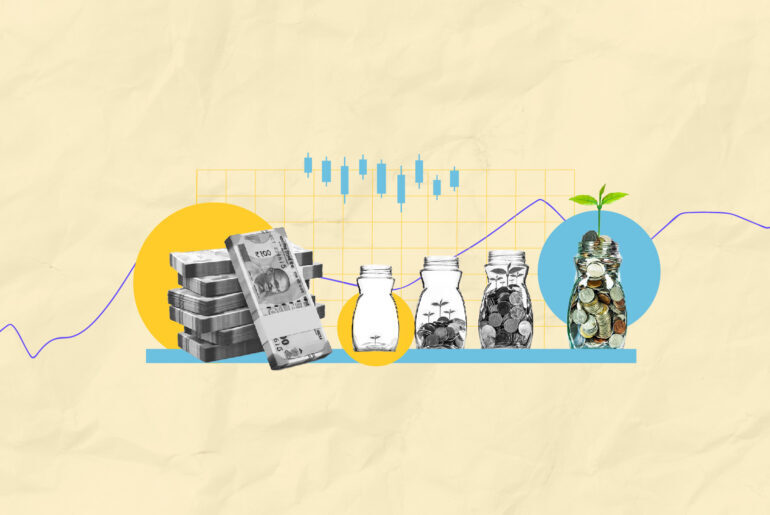Last Updated on May 24, 2022 by Anjali Chourasiya
If you’re an investor, one of your greatest joys would be seeing stock prices rise. Depending on your return expectations and risk appetite, you can make decent profits during a healthy market uptrend. However, stock market trends are not always upward facing. New investors find it baffling that stock prices change every second and have a hard time aligning their portfolios.
Understanding what moves and dictates the price of stocks is basic investment knowledge. It helps investors develop portfolios, invest wisely, and make profits in the long run.
This article will explore what causes stock prices to fluctuate and how to tap these swings to your benefit.
Table of Contents
What causes stock prices to fluctuate?
NSE Nifty and BSE Sensex are two common indicators in the context of the stock market index. So let’s look at some factors which drive the stock market index up or down:
Demand and supply
The price of a particular stock goes up if its demand increases for some reason. Likewise, stocks with low demand attract fewer investors, causing a price drop. For example, stock prices of air conditioners companies shot up last year with the government banning the import of the same with refrigerants from China. This was done to promote domestic manufacturing in the country.
Company earnings
A company making substantial profits with revenues exceeding quarterly projects will attract more investors. The price of stocks of such a company will usually spike. But if a company does not meet its projections, its stock prices will most likely drop.
Company news
Company-related positive or negative news affects its stock price. For example, a stock price rise can result from acquiring another company, diversifying into a new market, or an interest hike. Likewise, scams, lay-offs, shut-downs, etc., cause investors to sell stocks, driving down prices. For example, Bharti Airtel’s stock price rose to new heights with its announcement of venturing into 5G.
Stock mispricing
Overvalued stock prices are a hallmark of speculative bubbles that eventually pop, driving prices low as rapidly as their rise. Similarly, investors dump stocks out of fear that a company may be doomed after a downturn, resulting in undervalued stock prices.
Economic factors
Finally, macroeconomic and microeconomic factors play their part in fluctuating stock prices. Political unrest, natural/anthropogenic disasters, war, civil unrest, unemployment, inflation, availability of workforce, etc., all impact stock prices. Covid-19 pandemic can be a prime example here. It has kept the markets on their toes with constant highs and lows.
How to benefit from fluctuations?
Most often, mispricing of well-established, large-cap companies is because of temporary sensations arising from scandals, legal issues, shutdowns, etc. These factors bring down stock prices, but only temporarily. Likewise, bear markets or general economic pessimism often beat down companies with no significant shortcomings. But, again, it’s only temporary.
In other words, it is primarily the judgement of market participants that shifts the prices. When a large bunch of investors perceive a bright future for a company, they’d be more interested in buying stocks, thereby causing prices to rise. Similarly, the market will see a downtrend when the participants don’t feel great about future prospects.
But here’s the trick: as an investor, it is up to you whether you choose to follow the herd or simply wait. Temporary setbacks can cause a company’s stock prices to go down, but it doesn’t mean that the company is gone for good. Businesses recover, and that’s the most important thing you should remember as an investor.
Fluctuating stock prices are a market trait. However, as an insightful investor, you can benefit from dynamic market trends by not letting short-term volatility and losses cloud your judgement. Instead, wait for the prices to rise after a downtrend and sell when you have the chance of making substantial profits. Likewise, you can hang fire till the stock you want to buy is mispriced on the lower side. The key is to wait for the ripest opportunity.
52-week high vs 52-week low: A lesson for investors
Let’s look at the 52-week highs and lows of some BSE companies to understand the buy-low-and-sell-high mantra:
| Company | Current Market Cap (Cr.) | Current Price (As of 31 December 2021) | 52-week Low | 52-week High | Change (%) |
| Reliance Industries Ltd | Rs. 16,01,382.07 | Rs. 2,368.15 | Rs. 1,830.00 | Rs. 2,750.00 | 50.3% |
| Tata Consultancy Services Ltd | Rs. 13,82,280.01 | Rs. 3,736.85 | Rs. 2,701.00 | Rs. 3,990.00 | 47.7% |
| HDFC Bank Ltd | Rs. 8,20,164.27 | Rs. 1,479.80 | Rs. 1,342.00 | Rs. 1,724.30 | 28.5% |
| Infosys Ltd | Rs. 7,94,714.60 | Rs. 1,889.65 | Rs. 1,230.00 | Rs. 1,913.00 | 55.5% |
| Hindustan Unilever Ltd | Rs. 5,54,444.80 | Rs. 2,359.75 | Rs. 2,104.25 | Rs. 2,859.10 | 35.8% |
As evident from the table, the difference between the 52-week high and low is significant for all of these companies. However, these are established firms with negligible chances of the business’s worth overturning within a few months.
The point is this: it is solely the market participants’ sentiments that cause the fluctuations and lead to mispricing. The key is to play on the market sentiments and spot the right opportunity to trade and invest.
Conclusion
Several factors contribute to the ever-fluctuating price of stocks. It is a market characteristic that investors need to get used to and take advantage of as much as possible. If you’re a risk-averse investor looking out for long-term investment opportunities, temporary volatilities should not concern you largely. Companies that have survived the wraths of shifting market trends in the past have the potential to do so again.
- How To Declare Mutual Funds in ITR & Disclose Capital Gains in India? - Jun 6, 2025
- How To Sell or Exit Your Mutual Funds in India? - Jun 6, 2025
- Fund of Funds (FOF): Meaning, Types & Advantages - May 13, 2025





